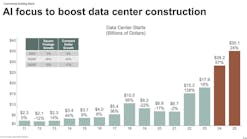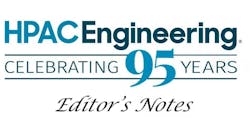Necessity is the mother of invention, they say. (Just as deadlines are the father of productivity!)
After decades of resistance, our industry is actually a leader in innovation these days, driven by prevailing market conditions and scientific imperatives that are allowing engineering creativity to flower throughout the built environment. And the newer, prevailing emphasis on energy efficiency has been embraced whole-heartedly by public and private owners looking to stretch dollars while maintaining tenant comfort for clients as diverse as high schools, hospitals, offices and data centers.
“The HVAC industry must keep pace with consumer trends,” explains engineer Mark Kuntz, CEO of Mitsubishi Electric Trane HVAC US LLC (METUS). “Sustainability is a core demand driver for energy-efficient technologies capable of reducing source energy and fossil fuel emissions… We’re also seeing a surge in the construction of high-performance buildings with integrated systems in the built environment.”
Indeed, that emphasis on harvesting data for optimizing building performance and commercial space usage is the subject of two separate innovation stories in this issue, one from Schneider Electric (p. 22) and the other from BitBox USA (p. 28). Both stories make clear that data will soon be driving even more decision-making, especially as occupants and facility managers become more and more comfortable with the new technologies.
“In the next five years, we see the user experience moving from the building engineer and maintenance purview to the end user,” writes Jeff McClain, CEM, of Schneider Electric Digital Energy. That migration will include an increasing reliance on machine learning (ML), he notes, where building systems will be designed to adapt on their own to changing circumstances.
“The industry is embracing innovation, but the focus still tends to be on solving problems one use case at a time,” says Burcin Kaplanoglu, PhD, executive director of the Oracle Construction and Engineering Innovation Lab. “The key to unlocking substantial, lasting value is in extracting new intelligence by centralizing and making use of the data generated by these new tools across the full asset lifecycle — production, installation and operation — of mechanical systems.”
Launched 14 months ago in the Chicago suburb of Deerfield IL, the Lab is a simulated worksite where contractors and subcontractors can experiment with field use of the internet of things (IoT), drones, autonomous equipment, augmented reality (AR), artificial intelligence (AI), machine learning (ML), and other developing technologies. (For more on the Lab, look for an onsite report from our own Kelly Faloon in the weeks ahead.)
That broad, holistic approach to problem solving is also manifest in the intersections of the sustainability and smart cities movements. Vast, global problems made more manageable by creating a network of interdisciplinary solutions.
“As cities commit to meeting rigorous decarbonization goals, there’s been a clear and decisive move to electrify the U.S. energy grid,” notes Kuntz. “(METUS) is supporting this trend towards strategic electrification, leveraging our industry expertise, plus high-performance heat pump and controls technologies to help cities find ways to meet these goals.”
According to the U.S. Energy Information Administration (EIA), roughly 20 percent of total U.S. energy use goes toward powering commercial buildings. And about 15 percent of those commercial buildings have building automation systems (BAS) that deploy controls, such as sensors that turn on lights or heating for a room, only when it’s occupied. Expect to see those numbers grow rapidly.
One surprising hurdle? Researchers at San Diego State University reported last month that many architects are still slow to include smart controls in building designs. Perhaps our engineer readers can encourage some of their creative comrades to innovate even more outside the box.
For more Editor's Notes from the author, click here.









